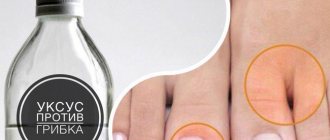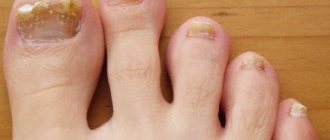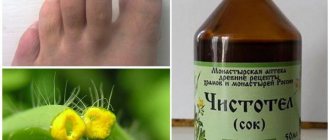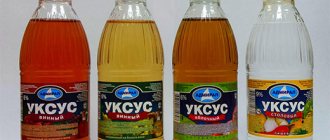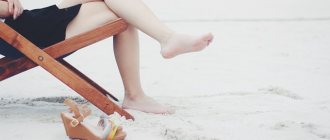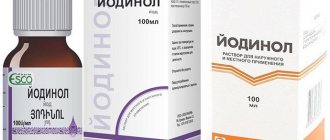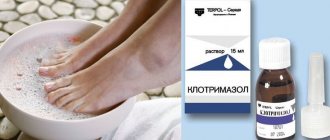Just a few years ago, fungal nail diseases were not given much importance, whereas now everyone understands the need for timely detection and treatment of a massive contagious fungal infection caused by a variety of dermatophyte fungi. Thanks to widespread public awareness, the number of visits to specialists with this pathology has increased, which in turn has led to an increase in the detection of mycoses of the feet. Since any deformation of the nail plate for no apparent reason (for example, injury) is primarily suspected of a fungal infection, self-diagnosis in this case is a decisive factor. Thus, any change in the nail plate is a reason to contact a dermatologist, because at least half of such disorders will have a fungal etiology, and the rest will require careful diagnosis, again carried out by a specialist.
Why, given the obvious simplicity of clinical diagnosis of fungal nail infections, do patients usually come to the appointment already with advanced forms of the disease? Most often, 4-5 toes are affected, with the most affected nail plate (usually the first toe) changed by more than half, and its thickening is about 2 mm. Such symptoms require long-term combined treatment, which is reflected in its cost. Factors leading to this situation:
1. Actually, fungal nail infection is a sluggish disease that does not lead to life-threatening conditions and does not cause pain or discomfort. More often it affects the elderly population, who often associate changes in appearance with the aging process.
2. The sick themselves are often embarrassed by the disease, are not prepared for the financial costs of treatment, or are confident that it is incurable. Many people begin to self-medicate and do not see the disease as a reason to see a specialist.
3. Since the disease primarily affects the feet, even during medical examinations or examinations by doctors, the matter usually does not reach the point of examining the feet directly, without specific patient complaints about changes in the nails. This is facilitated by the extremely short time allotted for seeing patients even in specialized institutions, which, unfortunately, forces doctors to examine them only for the main reason for the visit.
Fungal infection of nails lasts quite a long time
Therefore, the earlier the disease is detected, the higher the likelihood of its complete cure. In addition, an earlier start of therapy allows us to limit ourselves to the use of only external preparations and nail cleanings, and this is only possible if the infection has affected single nails from the distal or lateral edges of less than 1/3-1/2 of the plate. Local external therapy is used to treat the initial stages of fungal nail infection. Advanced forms of fungal infection require longer and more expensive treatment. Periodic preventive examinations and medical examinations of the population play a special role in the early detection of nail mycoses.
Effect of apple cider vinegar on fungus
Vinegar for nail fungus
The fungus is afraid of an acidic environment, so apple cider vinegar not only kills these microorganisms, but also prevents their reproduction. This is an excellent antiseptic that can quickly reduce symptoms of onychomycosis such as itching, irritation, and inflammation. In addition, the fruit acids contained in this product have a good effect on the structure of the nails.
Thus, apple cider vinegar:
- acts against fungi of nails of hands and feet;
- kills germs, bacteria and other harmful microorganisms;
- strengthens the nail plate
- relieves unpleasant symptoms of mycosis
- fights inflammation
However, apple cider vinegar alone will not help if you do not maintain hygiene:
- Wash your feet and hands regularly;
- Change socks and clothes on time;
- Take a shower at least once a day;
- Do not use other people's hygiene items;
- Avoid weakening the immune system due to vitamin deficiency.
- Do not walk barefoot in the bathhouse, sauna, or swimming pool.
Moreover, this home remedy may not help in all cases.
Preventive actions
Preventive measures are aimed at reducing the likelihood of onychomycosis infection to almost a minimum. Patients with weakened immune systems are more susceptible to this disease. Also at risk are people who neglect basic personal hygiene rules. Prevention of nail fungus comes down to the following rules:
- It is necessary to select quality shoes. It should not be tight or uncomfortable. Preference should be given to natural materials.
- If your feet are constantly sweaty or wet, you need to thoroughly dry your shoes after each use. For this you can use special electric heating pads. In a damp environment, the fungus feels comfortable and begins to actively reproduce.
- In public baths, saunas and swimming pools, only personal slippers and a towel are allowed. After visiting such places, you must definitely disinfect your shoes with potassium permanganate or apple cider vinegar.
- Tights and socks should be changed daily.
- The fungus really “loves” people with reduced immunity. This happens after long-term antibiotic therapy, due to stress. Therefore, it is necessary to regularly take care of the body’s defenses. You need to spend more time outdoors, try to eat right and exercise daily.
Any disease, including onychomycosis, is easier to cure at the initial stage of development. It is important to regularly examine your nails and skin for infection. If primary symptoms occur in the form of changes in the color and shape of the nail, or the appearance of uncharacteristic spots, you should consult a dermatologist.
Video - Treatment of advanced nail fungus with apple cider vinegar
When to use apple cider vinegar
Apple cider vinegar will not always help treat nail fungus. In some cases it will provide little or no benefit. We are talking about advanced stages of the disease. If more than a fifth of your nail is damaged, vinegar can only be used as an aid. But a doctor needs to deal with such a fungus. Don’t be shy or afraid of dermatologists - no one will think that you are sick because you don’t pay attention to your hygiene. Anyone can get a fungus - it is a very contagious disease. But it is the doctor who must prescribe medications that will really help.
Another case where vinegar should not be used is open wounds. With fungus, a situation where part of the nail peels off and falls off in pieces is not uncommon. The result may be painful sores. Naturally, if acid gets into them, you will not only get increased inflammation, but also severe pain as a result of a chemical burn.
How is it useful?
This product is obtained from apples that have undergone a fermentation process. It has a mild taste and pleasant aroma, and has great nutritional value compared to ordinary alcohol vinegar. The use of the product is wide and varied due to the presence of useful substances in its composition. These active biological substances have a beneficial effect on almost all organs and tissues of the human body, both externally and internally.
Apple cider vinegar has found wide application in cosmetology. Based on it, effective masks and lotions are prepared for whitening age spots and for cleansing the face of blackheads.
By dosing the composition and introducing additional ingredients, it can be used by women with different skin types to increase its elasticity and firmness, to get rid of wrinkles and reduce the manifestations of rosacea. The benefits for the skin become noticeable very soon after starting to use cosmetics due to the complex effects of such substances as:
- organic acids stop the proliferation of harmful bacteria and promote wound healing;
- Vita and microelements are needed to improve the protective functions of the skin, regeneration processes in it, and maintain metabolic processes in the epidermis at the proper level;
- enzymes and acids are involved in restoring the structural composition of collagen, since protein synthesis cannot occur without them.
The compositional features make it possible to use apple cider vinegar for feet in many painful conditions. Its bactericidal and refreshing effect is useful for excessive sweating and helps get rid of odor during sweating. Women, especially after childbirth, often develop spider veins on their legs.
Due to wearing uncomfortable high-heeled shoes, standing work, and varicose veins, your legs swell in the evening and discomfort may appear in them. Baths and wraps with vinegar will relieve the feeling of fatigue and heaviness, and will save you from swelling and pain in the legs. Traditional medicine recommends using the product for heel spurs, a disease that causes acute pain in the heel when walking. With frequent and severe muscle tension in athletes and older people, cramps may occur due to age-related changes. They appear especially often at night, preventing proper rest. For cramps, using vinegar in foot baths will be effective.
Many women are faced with a problem that does not cause pain, but causes great aesthetic discomfort - rough skin on the heels. Women spend a lot of money on visiting beauty salons, purchasing pumice stones and files, softening creams and scrubs, but they do not always get the desired result. The problem is aggravated in the summer after working in the country, and wearing open shoes becomes problematic.
Methods of use
Vinegar can be used in a variety of ways to treat nail fungus. Choose the appropriate option depending on your preferences and ease of preparation.
Baths
Vinegar baths are a great option for those who have 30 minutes of free time. After them, not only do your nails become healthier, but your skin also softens, your feet stop sweating a lot, and the unpleasant odor and itching disappear.
The simplest bath with vinegar is done like this: pour 150 ml of 5% apple cider vinegar into 5 liters of hot water. Keep your nails in this solution for about 20 minutes. Wipe dry, trim the affected nails at the root, and put on clean socks or gloves.
Baths with vinegar and other ingredients have also proven themselves to be excellent:
- Bath with vinegar and essential oils. They help remarkably not only against nail fungus, but also against other dermatological problems. When adding essential oils, you should remember that they are not suitable for everyone, as they are a fairly allergenic product. If you experience itching, red spots or a rash, immediately wash your skin with plain water and apply an allergy cream - for example, Allergosan. Add no more than 3-4 drops to the bath - this will be enough for a therapeutic effect.
- Baths with vinegar and soda. Add 1 tablespoon of soda and 50 ml of vinegar to 1 liter of water. While the reaction takes place, keep your nails in the bath for 25 minutes. Dry them thoroughly and do not wash them for at least 3 hours.
- Bath with vinegar and celandine. To prepare this bath, you need to purchase a collection of celandine at the pharmacy and pour 1 spoon of the herb into a glass of boiling water. Let it brew and pour in 4 liters of hot water. Add 100-150 ml of natural apple cider vinegar. Do these baths for 2 weeks every day for 30 minutes, and the result will not be long in coming.
- Baths with vinegar and hydrogen peroxide. Add 2 tablespoons of vinegar and 1 tablespoon of peroxide to hot water per 1 liter of water. Leave your nails on for 20-30 minutes. Wipe dry and apply antifungal cream.
Lotions
The lotion is a wet compress that is applied for a short time. For the vinegar lotion, you will need a medical cotton swab or a regular cosmetic cotton pad. Dip it in vinegar and apply it to the nail plate damaged by the fungus. Keep it this way for as long as possible - at least 1-2 hours until the vinegar evaporates. This option is good because it allows you to achieve faster results due to pure vinegar. For a better effect, you can add onion juice, peroxide or a little soda.
Applying vinegar to nails
Treatment of nail fungus with vinegar
Lubrication is a quick way to stop the development of nail fungus, but the effect of this treatment should not be expected quickly. The purpose of lubrication is to briefly apply vinegar to the damaged nail. Unfortunately, the effect of such treatment will be noticeable if you perform the procedure at least 10 times a day for 2-3 weeks.
However, you should not immediately dismiss this method of using vinegar. Lubricate healthy nails and you will stop the development of the disease.
Features of the pathological process
Infection of the nail plate fungus is medically known as onychomycosis. It is caused by dermatophytes. These are microorganisms that feed on keratin, the building material for nails. As a result of the active activity of the fungus, the plate first changes color, then begins to thin out/thicken and crumble heavily, collapsing down to the nail fold. Pathogenic microorganisms quickly penetrate the skin, causing an infectious process.
There are 3 types of onychomycosis:
- Normotrophic
. First, whitish spots appear in the thickness of the nail. Very quickly they change shade to yellow. The free edge of the plate remains unchanged. In rare cases, characteristic notches appear on it. - Atrophic
. The nail plate, under the influence of pathogenic flora, becomes thinner and rejected. - Hypertrophic
. The nail plate becomes dull and thickens. Then its color changes to gray, and brown inclusions may be observed. The nail itself is very crumbly.
The causative agents of onychomycosis are highly resilient. Poor symptoms of the disease in the early stages cause late diagnosis. As a result, the treatment process may take several months. All this time, a person’s life is accompanied by aesthetic discomfort. If therapy is stopped immediately after symptoms disappear, relapses are possible in the future. It is noteworthy that the fungus can become resistant to previously used medications.
Recipes with apple cider vinegar against nail fungus
In folk medicine, there are several dozen recipes for nail fungus, and many of them contain natural apple cider vinegar. Let's look at the most famous recipes.
Vinegar and baking soda compress
Apple cider vinegar compress for fungus
Take a small piece of gauze or a handkerchief, wet it generously with vinegar, and sprinkle baking soda on top fairly thickly. Apply the compress to the sore nails and cover with a bandage. Wrap the top with cling film or put on a bag. Secure the compress again. It must be done every other day for several hours. Pay attention to how you feel - you should not have any unpleasant feelings. If there is burning, pain or itching, remove the compress and wash the skin with water.
Compress with celandine
Brew a strong solution of celandine, for which take 1 tablespoon with the top of the herb and pour half a glass of boiling water over it. Leave for 30 minutes, then dip a cotton pad into the solution. Place the disc on your nail and pour a little pure vinegar directly into the compress on top so that excess liquid does not drain off. Bandage the compress and keep it on for 2-5 hours without removing it. You can leave it overnight. Also, a solution with celandine is good for a preparatory or preventive bath against fungus.
With sea salt
Sea salt perfectly strengthens nails, provoking their growth and strengthening the nail plate itself. To prepare a bath with sea salt and vinegar, you will need about a glass of sea salt per 5-7 liters of water and a glass of vinegar. The bath should be hot. If there are scratches or other damage to your feet, you will feel it immediately. If unpleasant or painful sensations appear, the bath should be stopped. A solution of salt and vinegar can also be used for compresses that are placed on the nail overnight.
Vinegar and baking soda are an ideal remedy for nail fungus
What's the benefit?
Apple cider vinegar is rich in valuable components and microelements: calcium, potassium, iron, pectin, selenium, phosphorus, various vitamins and organic acids. Baths with this product have enormous benefits for the feet:
- fight against fungus - suppression of infection and creation of a protective barrier against new microorganisms;
- removing dead cells from the skin and softening it;
- treatment of cracked skin on the heels;
- suppression of the activity of the virus that causes warts on the feet;
- reduction of foot sweating;
- elimination of unpleasant odor;
- softening of calluses;
- treatment of spider veins and varicose veins;
- relieving fatigue, feelings of heaviness, pain, itching and inflammation;
- nourishing the skin with vitamins and rales;
- normalization of the nervous system (there are more than 70,000 nerve endings on the feet);
- strengthening the nail plate.
Important! It is recommended to purchase apple cider vinegar that has a brown sediment at the bottom. This is a sure sign of a high quality product.
Contraindications
Vinegar is a food product that every person consumes, so there are no contraindications for its use. The only point worth paying attention to is the possibility of irritating sensitive or damaged skin. In this case, limit the use of vinegar and avoid getting it on your skin.
It should also not be used on young children. Such patients should be examined by a doctor and prescribed special medications appropriate for their age.
When using this product, remember - this is not a panacea for nail fungus, but an auxiliary remedy. Under no circumstances should you refuse treatment with traditional medications or ignore the dermatologist’s prescriptions.
Reviews about the effect
People leave a lot of reviews about the use of apple cider vinegar for feet and the effect it produces, which are mostly positive. People love that this affordable product can help with many problems, that it is easy to use, and that formulations are easy to make. There are especially many reviews from women who use the product itself or formulations based on it to care for the skin of their feet and heels. They note that they tried products from different manufacturers, but only with the help of apple cider vinegar were they finally able to get rid of cracked heels. Many people use baths made from the product to relieve the feeling of fatigue and heaviness in their legs. Baths relieve pain, relax and soften the skin.
Some people suffering from varicose veins have experienced improvement. It is often said that spider veins have been made invisible, but this took a long time. The effect was very positive when using the product to get rid of excessive sweating and odor. Many people are very happy that they were able to cure a heel spur. People also note that the frequency and intensity of nighttime cramps has decreased.
There are a small number of negative reviews. They say that the products dry out the skin and cause redness. But this happened in cases where the dosage was not followed and the formulations were prepared and applied incorrectly.
See below for the recipe for perfect heels.
Pros and cons of treatment
Like all other traditional medicines, vinegar has its pros and cons. For some it will help to quickly get rid of mycosis, but for others it will not be suitable at all. Still, before using this technique it is useful to know the pros and cons:
- Cheap remedy.
- Always available at home.
- Has no contraindications.
- Destroys fungus and accelerates nail growth.
- Ideal for complex therapy.
- Can be used as prophylaxis.
Among the disadvantages, it is worth noting the small therapeutic effect and visible results only at the initial stage of the fungus.
Basic rules for using the medicine
This simple mechanism makes the treatment of mycosis with apple cider vinegar effective if the following rules are followed:
- Careful selection of essence: the raw material – apple vinegar – must be natural, without impurities or chemical additives. Apple essence is easy to make at home.
- Take the necessary precautions: prevent the risk of spreading the fungus by increasing hygiene requirements, use personal items (towels, slippers), wash towels and socks after use.
- Strictly follow the recipe and options for using the medicine.
Forecasts at different stages of the disease
Any disease develops in at least three stages: initial, moderate and advanced. When using vinegar at the initial stage of nail fungus, the probability of complete cure reaches 70%. Almost all patients during the experiment by the end of the second week noted a noticeable improvement in the condition of the nail plate.
Bath for nail fungus with vinegar
In the middle stage, the method of using vinegar played a big role. Compresses and lotions brought the greatest results; baths improved the general condition of the nails, but did not cure the fungus. Lubrication did not give any visible result.
In advanced stages of the fungus, vinegar improved the general condition of the nails in 10% of patients, but recovery did not occur within a month. We can conclude that with a strong fungus and a large lesion, this method does not give results. The disease at this stage requires an integrated approach and the use of special antimycotic drugs.
Course of the pathological process
In the development of onychomycosis, it is customary to distinguish 3 stages. The sooner a patient seeks help from a doctor, the higher the likelihood of a quick recovery. Otherwise, the process will be long and require a lot of patience.
| Stage of disease development | Specific signs |
| Initial | The nail maintains a smooth surface and healthy color. Upon close examination of the plate, small whitish specks are barely visible. Onychomycosis can only be confirmed through laboratory diagnostics. |
| Average | The nail plate loses its healthy shine. The shade changes a little. The edges of the nail become deformed. |
| Launched | The surface of the nail plate becomes loose and even bumpy. Its shade can vary from dirty yellow to gray. Possible delamination and detachment from the nail bed. |
If left untreated, a fungal infection will continue to affect the nail. Onychomycosis is also contagious. A person with this disease poses a danger to family members.
Prevention with vinegar
After you have undergone treatment and seemingly defeated the fungus, there is always a risk of relapse. Unfortunately, the situation when symptoms return after a month or two is not uncommon. To prevent this from happening, it is necessary to carry out preventive measures for 2-4 weeks. They include:
- More frequent changes of underwear and socks.
- Shower regularly.
- During active physical activity, it is necessary to maintain hygiene.
- Do not wear underwear and socks made of artificial materials.
- Maintain temperature conditions in clothing.
- If there is a lack of vitamins, take a general strengthening course.
- Take a bath with vinegar every day for 2 weeks, then every 3 days.
Following these rules will help defeat the disease and prevent its return.
How to cure with lotions
Another way to treat fungus is to use lotions. The ingredients are the same, but instead of baths, pieces of cloth are applied to the affected area in a moistened solution.
Lotions are effective in the fight against fungal diseases on nails
More detailed information about lotions:
How to breed
The advantage of this method is that apple cider vinegar is not diluted. All you need is a container, liquid, a cotton pad and an adhesive bandage.
How to use the solution
Pour some vinegar into a container and soak a cotton pad in it. Then take it out and squeeze it out. Then apply it to the affected area of the nail and secure it with an adhesive plaster. Put a clean sock on top.
The procedure is done before bedtime. The lotion should remain on all night. Repeat these steps every day for two weeks. And after this time has passed, a day later until the fungus disappears.
Preparatory measures
Not all patients know how to properly treat nail fungus with vinegar. First, you need to examine the area around the affected nail for redness, sores, or rashes. If there is no damage, then the products are used according to the prescription. If there are contraindications, your doctor will help you choose other medications.
Before using acetic acid for fungus, you need to prepare your limbs:
- Make a bath for your hands or feet for 15 - 20 minutes;
- Wipe your limbs dry;
- Using a soft nail file, remove the top keratinized layer that has peeled off. Use a pumice stone to clean the skin, cut off the skin bumps with scissors;
- Cut off the legs, sand the plate;
- Rinse your feet and dry with a towel.
After preparation, a vinegar mixture is applied to the nail plates. To avoid skin irritation, treat the area around the nail with a rich cream.
Important!
After treating your nails, before applying a vinegar-based product, you should disinfect the tool. It is important to maintain hygiene so as not to infect others.
Preparing your feet for treatment
special instructions
Mixtures with vinegar for mycosis are prohibited from being used at home in the following cases:
- Hypersensitivity to acetic acid;
- Tendency to allergies;
- Pregnancy, lactation;
- Children under 12 years old;
- Skin diseases (psoriasis, eczema);
- Abrasions, scratches, wounds on the damaged area;
- Diabetes mellitus (due to malnutrition of the feet).
Contraindications to the use of vinegar
Before using the product, you need to conduct an allergy test. To do this, rub a little mixture into the skin on the wrist or elbow. In the absence of redness, itching, or rash, it is used according to the prescription.
For skin lesions or diseases in the affected area, acetic acid will only intensify the inflammatory process. It is used only after the damaged area has healed.
Children have very sensitive skin, so vinegar causes irritation and burns. Pregnant and lactating women also have increased sensitivity of the epidermis, so it is better to choose less aggressive agents. When using a low concentration solution, nursing mothers need to be careful not to get it on the breast, as it will cause a burn to the baby's mouth.
Sometimes redness, burning or itching occurs after treatment. Then you need to stop treatment and consult a doctor. When using a solution with a high concentration, a burn occurs.
Attention!
If vinegar gets on the mucous membranes of the eyes, they should be immediately rinsed with water.

